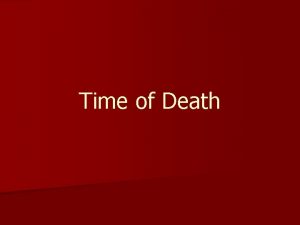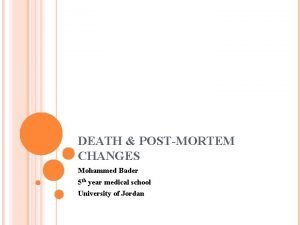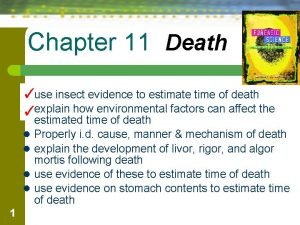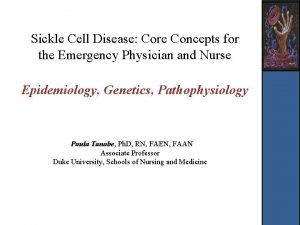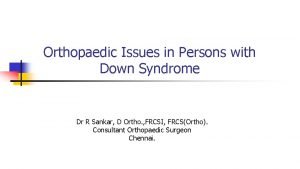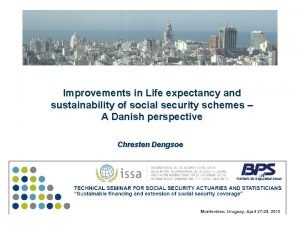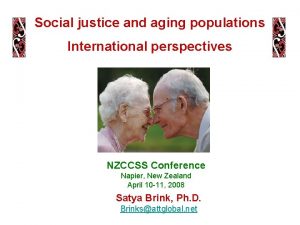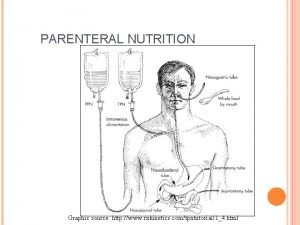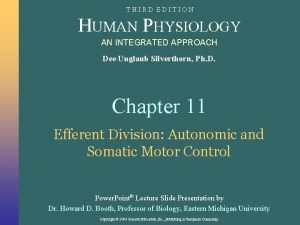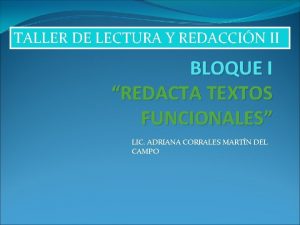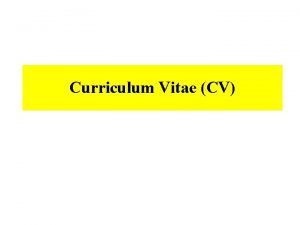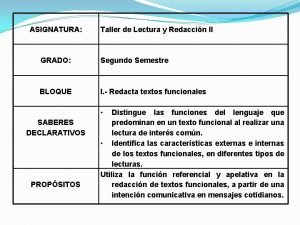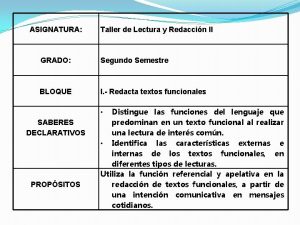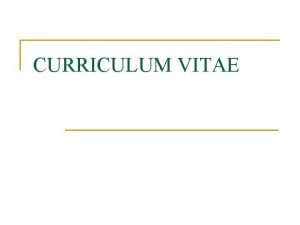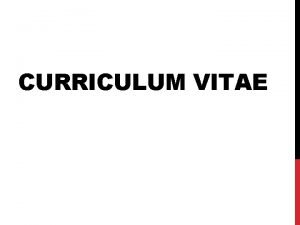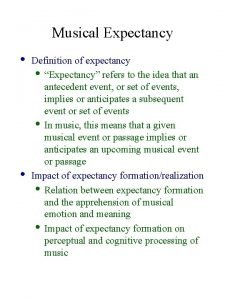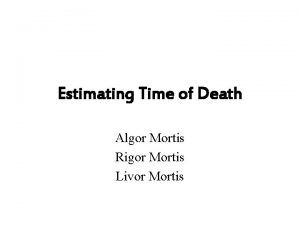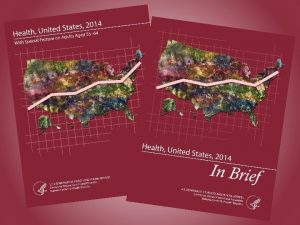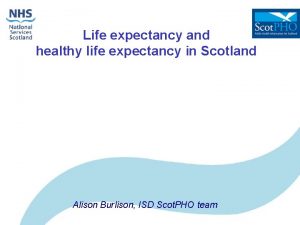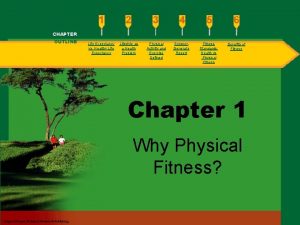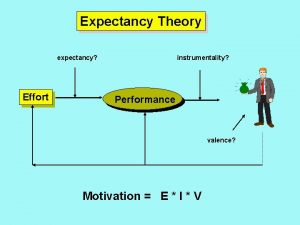Curriculum Vitae Curriculum Mortis 80 Life expectancy 70














































- Slides: 46

Curriculum Vitae - Curriculum Mortis 80 Life expectancy 70 60 50 40 30 35 yr 20 18 yr 10 0 Real yrs 1956 born 1978 BA 1982 DPhil 1998 Married 2006 Gresham 35 th Pf Physic

Life and death in the new millennium q Where were the first improvements in health and longevity? q Why did life span double in Britain after 1800? What population processes? Which interventions? q Are we reaching maximum life expectancy? q Are "developing" countries actually developing?

Gresham College "The Third Universitie of England" (1615) 1596 Matthew Gwinne, 1 st Professor of Physic, Royal Physician, author of tragedy Nero 1608 "I ever have studied physic…by turning o’er authorities…" (Shakespeare, Pericles) 1647 Professors "so superbiously pettish…" 1720 Lectures "should not be… intermingled with exhortation…" 1799 Lecture in Latin at 12 noon, vernacular at 1 pm 1904 WH Thompson (divinity) Nature and Immortality

Terms of engagement q Health of humans in context of environment and evolution q Seeing is believing q Distinguish known versus unknown q Not just what happens but why q Ask scientific questions for which I have no answer q Focus on populations (epidemiology) rather than individuals (clinical)

Q 1. Where were the first major improvements in health and longevity?

Industrial (r)evolution, health (r)evolution Life expectancy at birth (years) Life expectancy in England 1300 -2000 80 Wrigley & Schofield 70 Human Mortality Database Clark 60 50 40 30 20 1300 1400 1500 1600 1700 1800 1900 2000

THE SPECTRUM OF LIFE SPANS From hunter-gatherers to… … Japanese women

Evolution: "Nasty, brutish. . . " Survival of hunter-gatherers and Japanese Percent surviving 100 80 60 40 20 Hunter-gatherers Japanese women 0 0 20 40 60 Age (years) 80 100

Are humans more flexible than chimpanzees? Percent surviving 100 Wild chimps Captive chimps 80 60 40 20 0 0 20 40 Age (years) 60 80

Q 2. What population processes caused life expectancy double in 150 years?

Fundamental equation of population biology Population = + births change – deaths + immigrants - emigrants

Elim-i-nate the negative, accen-tuate the positive

Feedback in health & population

Industrial (r)evolution, health (r)evolution Life expectancy at birth (years) Life expectancy in England 1300 -2000 80 Wrigley & Schofield Human Mortality Database Clark 70 60 50 500+ years of stasis → negative feedback 40 30 20 1300 1400 1500 1600 1700 1800 1900 2000

Thomas Robert Malthus 1766 -1834 Principle of Population (1798) population, if unchecked, increases geometrically 2, 4, 8, 16, 32, 64, 128… but food supply grows arithmetically 1, 2, 3, 4, 5, 6, 7, 8… so population outruns food supply

Infant mortality per 1000 births Malthus in 16 -17 th century London? Poorer households had more child deaths 300 250 low income, high death rate 200 high income, low death rate 150 100 8 London parishes 1538 -1653 (Landers 1993) 50 0 10 20 30 40 50 60 Households with "substantial" taxable income (%)

POSITIVE FEEDBACK

Rapid increase → positive feedback

John Graunt (1620 -1674) Observations on… the Bills of Mortality 1662

Causes of Death in the Bills of Mortality Childbed: death of mother from infection following childbirth Chrisomes: death of infants in the first month of life (before baptism) Consumption: tuberculosis Dropsie: abnormal swelling due to build up of clear, watery fluid Drowning, Execution, Murder Flux: dysentery Gowt: gout, inflammation, build up of uric acid in the tissues Kingsevil: scrofula, tuberculosis of the neck Livergrown: enlarged liver, possibly rickets Purples: rash due to spontaneous bleeding in to the skin; in newborns, may be insufficient vitamin K Quinsy: acute inflammation of the tonsils Surfeit: vomiting from over eating or gluttony Teeth: death of a teething infant

One death, one cause?

"Malnutrition-infection complex" Fewer infections e. g. less diarrhoea Better nutrition

Q 3. What in(ter)ventions allowed life expectancy double in 150 years?

1 Agriculture and nutrition (1) Agriculture elimination of famine inin. England Elimination of famine England Number of famines each century 14 Excess food only 20 -30% pre 17 th century, with same fluctuation in yield 12 10 8 6 4 2 0 average pre-17 th 18 th Centuries 19 th 20 th

2 Public health "sanitation revolution" John Snow (1813 -1858) On The Mode of Communication of Cholera (1855) Edwin Chadwick (1800 -1890) Sanitary Condition of the Labouring Population of Great Britain (1842)

3 Microbiology diagnostics vaccines C 17 th C 19 th 1890 s drugs C 20 th

Q 4. Are we reaching maximum life expectancy?



Q 5. Are "developing" countries developing?

William Gibson "The future is already here, it's just unevenly distributed"

Human population in round numbers (2001) Population Births Deaths Net growth Max growth 6. 2 billion 133 million 60 million 73 million 1. 2% per yr 85 m in 1980 s



Fate of 100 boys born in different countries in 2001 Japan UK 80 India 60 Sierra Leone Russia 40 Zimbabwe 20 Age class (years) 99 95 - 89 85 - 9 -7 75 69 65 - 9 -5 55 49 45 - 39 35 - 29 25 - 19 15 - 59 0 <1 Percent surviving 100

Global distribution of afflictions communicable, non-communicable, injuries

Deaths per million population Where 60 million people die 8 6 double burden of disease in low-income countries Low-middle income High income 4 2 0 Communicable, pregnancy, nutrition Noncommunicable Injuries


Life expectancy is converging in lowand high- income countries Life expectancy (years) 80 70 Low-middle income High income 60 50 40 30 1960 1990 2002

Thomas Jefferson "Every generation needs a new revolution"

ic a si a ra Eu fr A a ic si a A Ea st er A m SS L S id M 2 si a 4 1900 -1950 8 A 6 1850 -1900 10 E ai n rit B Years gained per decade Life expectancy gains and losses worldwide since 1960 -1990 -2002 0 -2 -4

Chou En-lai Q: What has been the impact of the French revolution? A: "It's too early to tell"

China: the short march to long life Life expectancy at birth (yr) 85 78 75 73 1952 1975 2002 71 69 65 65 55 48 45 41 38 35 UK China Africa 50

History of longevity q Human longevity - astonishingly plastic product of evolution life span x 2 in Western Europe 1800 -1950 q Escaping Malthus, the power of positive feedback from environmental to genetic control q Direct route to longer life nutrition → epidemiology (public health) → microbiology (diagnosis, drugs and vaccines) q Not underestimating… science, social institutions, capital, skilled labour

"Developing" countries q Life spans range from hunter-gatherers to industrial but converging, with some exceptions q Cheap, effective technology to exploit +ve feedback outpaced the 1800 -1950 revolution China and others since 1950 q Lagging countries suffer old problems and new "infection-malnutrition", now with chronic disease and AIDS; major reversals in E Europe & Africa q Technology only partly compensates for lack of science, institutions, capital, and labour

William Stewart US Surgeon General 1969 "It is time to close the book on infectious diseases…"
 Autolysis
Autolysis Cadaveric spasm
Cadaveric spasm Somatic death
Somatic death Site:slidetodoc.com
Site:slidetodoc.com Life expectancy of sickle cell patients
Life expectancy of sickle cell patients My favourite animal panda
My favourite animal panda Life expectancy for down syndrome
Life expectancy for down syndrome Why does a star's life expectancy depend on mass
Why does a star's life expectancy depend on mass Island with longest life expectancy
Island with longest life expectancy Life expectancy evolution
Life expectancy evolution Fetal alcohol syndrome life expectancy
Fetal alcohol syndrome life expectancy Xyy male syndrome
Xyy male syndrome What was the life expectancy in 1500
What was the life expectancy in 1500 Life expectancy definiton
Life expectancy definiton Page life expectancy
Page life expectancy Fetal alcohol syndrome life expectancy
Fetal alcohol syndrome life expectancy Puritan life expectancy
Puritan life expectancy Metoclopromid
Metoclopromid Health life expectancy
Health life expectancy Uk life expectancy 2021
Uk life expectancy 2021 Rohhad life expectancy
Rohhad life expectancy What is progeria
What is progeria Cystic fibrosis life expectancy
Cystic fibrosis life expectancy Spina bifida occulta images
Spina bifida occulta images Edwards syndrome images
Edwards syndrome images Life expectancy world bank
Life expectancy world bank Deuteranomaly
Deuteranomaly Frilled lizard
Frilled lizard Características externas de cuadro sinoptico
Características externas de cuadro sinoptico Curriculum vitae de jesus de nazaret
Curriculum vitae de jesus de nazaret Special skills for a job application
Special skills for a job application Cv british
Cv british Contents of curriculum vitae
Contents of curriculum vitae Caracteristicas externas de memorandum
Caracteristicas externas de memorandum Cv referees
Cv referees Mapa conceptual características externas
Mapa conceptual características externas Cv chronologique
Cv chronologique Importancia de un curriculum vitae
Importancia de un curriculum vitae Minuta curriculum vitae
Minuta curriculum vitae Arnagon
Arnagon Curriculum vitae esquema
Curriculum vitae esquema Curriculum vitae unico
Curriculum vitae unico Curriculum vitae výslovnost
Curriculum vitae výslovnost Science experts network curriculum vitae
Science experts network curriculum vitae Components of a curriculum vitae
Components of a curriculum vitae Cual es la sexta regla del manual de mooney
Cual es la sexta regla del manual de mooney úradný životopis
úradný životopis
